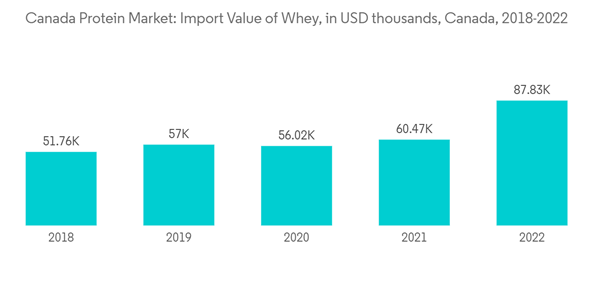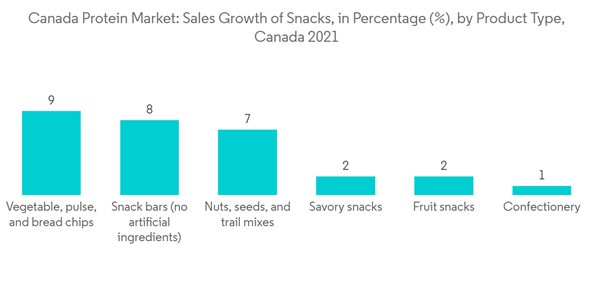Key Highlights
- The demand for protein-rich foods and supplements is fueling the growth of the protein market. Trends like the emergence of functional and fortified protein products, the popularity of plant-based protein, and the rising need for high-quality, sustainable protein sources have driven the protein market. Additionally, socioeconomic trends like growing urbanization, rising incomes, and aging populations are ultimately driving the increased protein consumption that is resulting from this population rise.
- Further, increasing the influence of social media to go green and go vegan is boosting the demand for plant-based protein alternatives among Canadian customers. The compatibility with vegetarian, vegan, and flexitarian lifestyles is now spotlighting plant-based protein sources, boosting the protein alternative market.
- Moreover, consumers and athletes are looking for natural and less processed nutritional solutions with proven benefits. Many protein manufacturing companies are launching new nutritional solutions to support sports nutrition manufacturers. For instance, in April 2023, Arla Foods Ingredients announced the launch of its new line of whey proteins branded as Nutrilac ProteinBoost, which is based on a patented microparticulation technology. The company claims that the products in the range have wide applications in the dairy and sports nutrition spaces, including yogurt, desserts, and dairy beverages.
Canada Protein Market Trends
Increasing Consumer Health Consciousness
- Consumers these days are more conscious about their health. For instance, the majority of the Canadian population are members of fitness clubs. The growing emphasis on staying healthy and in shape and rising participation in sports, health clubs, sports clubs, and gyms. These are some of the key drivers contributing to the growth of the sports nutrition industry. This further drives the protein market in the country since proteins are essential for muscle growth and repairing body tissues after a heavy workout.
- Usually, whey protein is highly preferred by fitness enthusiasts in order to maintain their protein intake. Whey protein is absorbed much faster and is also a rich source of cysteine, an amino acid thought to prevent post-exercise muscle fatigue. Whey protein also has a much higher content of branched-chain amino acids that help reduce protein degradation during heavy exercise and boost muscle synthesis.
- For instance, according to the UN COMTRADE statistics, in 2022, the import value of whey in Canada accounted for USD 87.828 million, while the import value in 2021 accounted for USD 60.473 million. In 2022, the major exporters of Whey to Canada include countries such as the United States, New Zealand, Australia, Argentina, and Denmark. Hence, the import value indicates that the protein requirement is further expected to increase in the country during the forecast period.
Protein Bars are the Fastest Growing Market Segment
- Consumers prefer buying protein bars for various purposes, such as weight management, improving muscle mass, and increasing energy. Additionally, fitness clubs' marketing initiatives promoting protein bars as a meal replacement alternative have dramatically increased these products' sales. The market is anticipated to experience an increase in demand during the projected period due to the rising popularity of protein bars and the rising number of fitness clubs in the country. Owing to their high nutrition levels, protein bars are gaining prominence among health-conscious consumers.
- Therefore, manufacturers are launching innovative products in this market segment. For instance, in January 2023, Kellogg Canada launched its extensive line-up of new product offerings, including RXBAR Vanilla Almond Protein Bar. The company claims that the product is minimally processed, features natural ingredients, and contains no added sugar. Further, it is claimed to provide 12 g of protein. Thus, all the above-mentioned factors drive the market positively in this country.
Canada Protein Industry Overview
The Canada protein additives market is highly fragmented. The major foreign players in the market are Agropur Dairy Cooperative, Archer Daniels Midland Company, CHS Inc., DuPont de Nemours Inc., and Fonterra Cooperative Group Limited (sorted alphabetically). Some of the regional companies manufacturing food additives in the country are Associated British Foods, Cordis SA, CSB-System Latinoamerica, Eurochem SA, Assuan Investment Export Import Ltd, and Danone.Further, the companies have been introducing new and innovative using natural and plant-based proteins so as to make their product unique from the existing products. Owing to the rapidly developing nature of the market, new product innovation has become the most commonly used strategy among all, as it helps in understanding the changing needs of the various application industries in the market.
Additional Benefits:
- The market estimate (ME) sheet in Excel format
- 3 months of analyst support
This product will be delivered within 2 business days.










